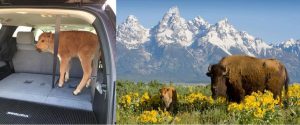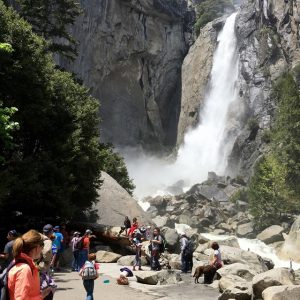BY MADISON RAE | SQ ONLINE WRITER | SQ ONLINE (2016-17)
____________________________________________________________________________
With summer and winter break behind us and spring break close ahead, many of us inevitably have travel on our minds. Luckily for those of us in California, we’re living in a state with 27 national parks and 36 national natural landmarks. Millions visit the parks each year, as ecotourism is becoming more popular. However, the increasing number of visitors to national parks and other biodiverse areas raises some concerns about conservation of and human impact on the environment.
The International Union for Conservation of Nature’s (IUCN) defines ecotourism as “environmentally responsible travel to natural areas, in order to enjoy and appreciate nature, […] promote conservation, have a low visitor impact and provide for beneficially active socio-economic involvement of local peoples.” This description shows the best side of tourism in nature; the visitors described have the support of local cultures in mind and follow the classic guideline of “take only pictures, leave only footprints.” Their fees, donations, and purchases of local products support the ecosystems and communities they visit. But what about the people who don’t follow such guidelines? Are visitors as a whole more helpful or harmful?
In May of 2015, we saw, arguably, the worst-case -scenario of humans interacting with nature: a bison calf that had to be put down after visitors brought it into their car in an alleged attempt to protect it from the cold and starvation. It’s an attitude that is so difficult to work with in the conservation world – people who love wildlife and want to protect it, but mistakenly act in ways that actually damages nature. How can we correct them and still maintain their support for conservation efforts? They see animals that look hungry or cold and try to provide them with food or shelter, when this actually damages the animals’ chances of survival. Public warning signs demand visitors refrain from feeding the animals, and many parks have strict rules about food storage to prevent wildlife from entering cars and campgrounds. Many people choose to disregard warnings about feeding animals that appear to be small, cute, or harmless, but giving “human food” to wild animals almost always causes problems. Human food can be potentially deadly to the animal, and repeated feedings by many tourists over time will encourage the animal to seek out humans for food. Down the line, some animals develop issues fending for themselves when they begin relying upon people for food. This contact is equally dangerous for humans, as they can be bitten or have their cars or campsites torn apart by larger, more dangerous animals. Research being conducted by UCLA scientist Daniel Blumstein suggests that even regular, “benign” interaction between humans and animals can desensitize animals to real threats. The baby bison previously mentioned ended up wandering the park, coming up to visitors and getting close to moving cars, because it no longer saw people as threatening.
____________________________________________________________________________
 Left: The baby bison in the trunk of the visitors’ car. (Source) Right: A bison and calf in Yellowstone park. (Source)
Left: The baby bison in the trunk of the visitors’ car. (Source) Right: A bison and calf in Yellowstone park. (Source)
____________________________________________________________________________
Additionally, as the number of park visitors rise, there comes the issue of balancing preservation and development. National parks have become much more developed over time to promote accessibility and safety as the number of hikers and campers increase. The more visitors they have each year, the more revenue that can go towards improving the park. However, more visitors means the parks may need to develop the land; this can include more accessible trails, additional campgrounds or cabins, more information/ranger stations, increased safety precautions, and so on. The balance lies in keeping visitors safe and happy while maintaining as much of the landscape as possible and allowing wildlife space to live and grow in peace.
As difficult as some of this sounds, there is a bright side to increased ecotourism. As the IUCN’s definition states, true ecotourism is environmentally responsible. For all of the visitors who cause problems, there are an equal number of visitors who follow park rules, respect the land and rangers, and are dedicated to the principles of conservation. Donations to conservation efforts keep research and preservation alive. Another method of support for ecotourism hotspots is fair trade products; these products, often food, jewelry, clothing, or art, are sustainably produced by local communities and provide an alternative to large scale corporations that may be damaging to the environment and local communities. This is a good way to provide money for production that protects delicate environments and supports small communities that are located near or within the area.
____________________________________________________________________________
 Visitors to Yosemite National Park observing the falls. (Source)
Visitors to Yosemite National Park observing the falls. (Source)
____________________________________________________________________________
In La Jolla, we have many different efforts to preserve biodiversity and promote balanced interactions between humans and nature. The Cleland Lab here at UC San Diego is working to rehabilitate and protect our coastal environment, and many resources are available to teach residents and tourists how to safely coexist with coastal wildlife like stingrays. Summer is prime season for stingrays in Southern California, and they can be seen in large numbers right here at Black’s Beach and along the rest of the coast. Scripp’s Institute of Oceanography and other local sources offer information each year so that beach visitors and stingrays alike can safely enjoy the beach. With a little work, we can peacefully coexist with ecosystems worldwide. When interacting with nature, the best policy is always to “take only pictures, leave only footprints.”
[hr gap=”0″]
Sources:
https://www.nps.gov/state/ca/index.htm
https://www.sciencedaily.com/releases/2016/01/160108134837.htm
http://www.nature.org/greenliving/what-is-ecotourism.xml
http://www.natureworldnews.com/articles/17403/20151011/eco-tourism-unexpected-threat-nature.htm
http://labs.biology.ucsd.edu/cleland/cleland/Home.html
http://www.national-park.com/welcome-to-yosemite-national-park/